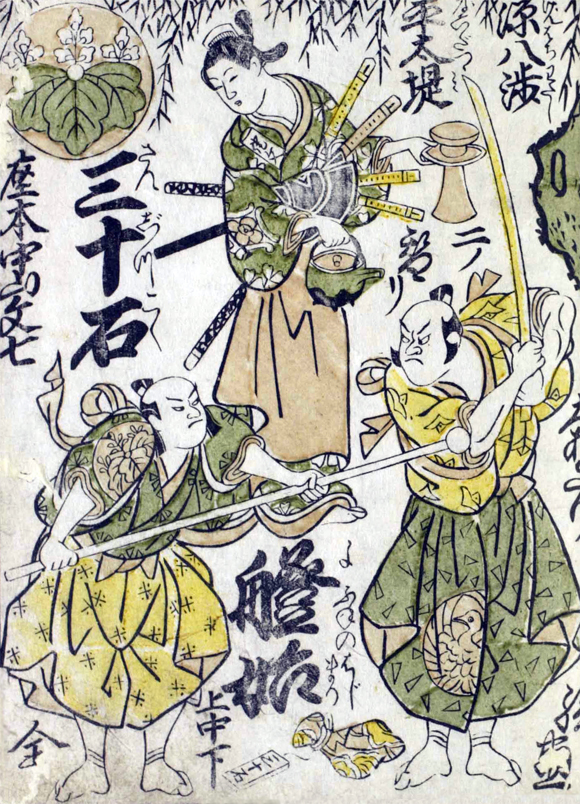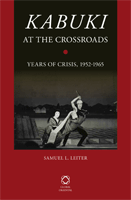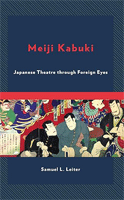| SANJIKKOKU YOFUNE NO HAJIMARI |
| Play title | Sanjikkoku Yofune no Hajimari |
|||
| Author | Namiki Sh˘z˘ I | |||
| History |
Namiki Sh˘z˘ I's ni-no-kawari drama "Sanjikkoku Yofune no Hajimari" was premiered in the 12th lunar month of 1758 in ďsaka at the Kado no Shibai [more details]. The opening day was the 22nd day of the 12th lunar month of the 8th year of the H˘reki era, which was the 20th of January 1759 in the western calendar. For the very first time in Kabuki history, a mawari-butai, invented by Namiki Sh˘z˘ I, was built and used on the stage of a theater. This drama unfortunately fell into oblivion but it has a huge potential for a revival at the National Theatre in the future to come! |
|||
| Structure |
The drama "Sanjikkoku Yofune no Hajimari" was in 5 acts. |
|||
| Key words |
Adauchi Adauchimono Chisui K˘ji Gand˘-gaeshi Ge'nin Hikid˘gu Kanekashi Kawamura Zuiken Keisei Kuruwa Mawari-butai Ni-no-Kawari Sanjikkokubune Seppuku Sewamono Shimabara Suimon Taiko Mochi Watashimori Yodogawa Yodo-han Yodo-j˘ Yűrei |
|||
| Summary |
The chief character in this play is the seventeenth-century figure Kawamura Zuiken, renowned for his engineering feats and riparian works in Edo. Against the background of the construction of the Yodo River waterworks, the drama-a variation on the typical adauchi ky˘gen-reveals the bloodshed and suicide of Hanamitsu Kenp˘ and the culmination of the suffering endured by the family of his retainer, Shind˘ Genpachi [2], when they achieve vengeance against their enemy. The otherwise sprawling play's scenes contain clear dialogue and humanly viable characterizations. This often strange work borrows ideas from such classics as Kanadehon Chűshingura and Futatsu Ch˘ch˘ Kuruwa Nikki, but is said to have a rough vitality of its own that sets it off from the more polished Kabuki familiar today. The clever young dramatist filled the work with scenic interest by his frequent use of such spectacular techniques as gand˘-gaeshi and hikid˘gu, but what makes his play epochal is his utilization of the mawari-butai, traditionally believed to first have been employed here, although a cruder revolve is believed to have predated it. The engineer Kawaura Ryűken [1], in service to the shogunal court, is overjoyed to read a love letter from Miyuki, the wife of the Kamakura envoy Hanamitsu Kenp˘, which he thinks refers to him. He discovers, however, that it really is to Kenp˘ and was used to deceive him into seeing that the latter was safe while carrying out his duties. The enraged Ryűken ridicules Kenp˘ until the latter cannot bear it any longer and strikes Ryűken. Kenp˘ leaves his affairs in the hands of Mifune, wife of his retainer, Shind˘ Genpachi, and commits suicide for this infraction. Ryűken orders Genpachi to build the Yodo River ferry crossing, and Sekiguchi Heita, Ryűken's brother, to build the river embankment, but the men's enmity prevents them from making progress until their work is transformed into a competition. In order for Genpachi to retrieve a ransom document on behalf of Agemaki, courtesan mistress of Kenp˘'s brother, Hanamitsu Nuinosuke, he must concede victory to Heita. Yodo Yozaemon, master of Yodo Castle in Yodo Domain, who observed Kenp˘'s seppuku, declares that Miyuki, Nuinosuke, and Genpachi have been disinherited from the Hanamitsu clan by Hanamitsu Sh˘gen, while he disinherits his sister Kich˘ (Nuinosuke's fiancÚe). Right after this, Sh˘gen seizes a sealed shogunal letter and is killed by Kumamoto Bennosaku. The wounded Mifune enters and dies. Ofune, Mifune's sister, becomes Genpachi's second wife and they raise their daughter, Omatsu. However, Bennosaku, learning that Omatsu was born in the month and year the dog, kills her, and makes a potion of her liver and the white hair of Ofune's father, the watashimori Mojibŕ, which Bennosaku drinks, completely transforming his features into those of Ryűken's father. The ghost of Omatsu leaves in a palanquin to sell herself in the Shimabara quarters. In Shimabara, Omatsu's ghost becomes the courtesan Tokiwagi, and her mother, Ofune, is her maid, although she does not realize the identity of Tokiwagi. Mojibŕ and Genpachi arrive and tell Ofune of Omatsu's death, which grieves her. Genpachi chases after Heita, who has run off with Nuinosuke and Agemaki, kills him, and retrieves the Sh˘gun's letter. Ryűken, who must protect an imperial envoy, stays at Yozaemon's mansion. Kich˘ is arrested for shooting at Ryűken. Discovering that she is Ryűken's abandoned child, born in the year and month of the dog, she kills herself. Her blood is mixed in a potion and, when given to Ryűken's father to drink, he resumes Bennosaku's appearance. Yozaemon devises a way of pulling a boat up the river with ropes. He sends off Koichi, his child by Kich˘, and peace comes to the Hanamitsu family. Ofune and Agemaki row a boat (a sanjikkokubune) and slay Bennosaku when he appears from the sluice. Ryűken, surrounded by Yozaemon and others, takes the name of the wise man Sait˘ Kuranosuke.
|
|||
| Notes |
[1] The name of the engineer was changed (Kawaura Ryűken instead of Kawamura Zuiken) to slightly disguise his identity and avoid the Shogunate censorship. [2] Hanamitsu Kenp˘ was played by Nakayama Shinkur˘ I and Hanamitsu Kenp˘'s retainer Shind˘ Genpachi was played by Nakayama Shinkur˘ I's disciple Nakayama Bunshichi I. Quite logical from a hierarchal perspective! |
 |
|
The cover of the ezukushi banzuke for the staging of the drama "Sanjikkoku Yofune no Hajimari" in the 12th lunar month of 1758 in ďsaka at the Kado no Shibai with Nakayama Bunshichi I (left), Nakamura Kiyosabur˘ I (center) and Mimasu Daigor˘ I (right) in the roles of Shind˘ Genpachi, Genpachi's ny˘b˘ Mifune and Sekiguchi Heita |
|
|
| Contact | Main | Top | Updates | Actors | Plays | Playwrights | Programs | Links | FAQ | Glossary | Chronology | Illustrations | Prints | Characters | Derivatives | Theaters | Coming soon | News |


